Lin Wei: Landscape, 2004
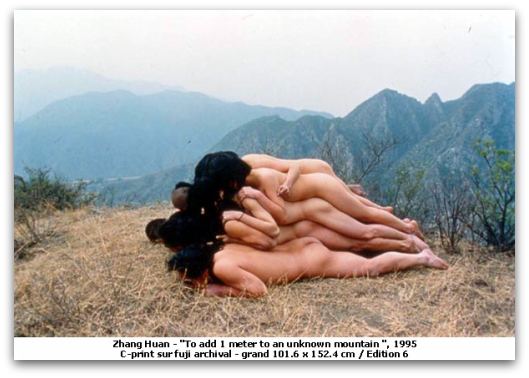
Regina Hackett takes her Art to Go
In a video at Western Bridge, one child reads from Bill Clinton’s welfare reform speech as others unwrap what prove to be empty boxes in a rapid-fire blur.
“Work organizes life,” observed Clinton, ringing the wrong bell.
“Arbeit Macht Frei” (“Work will set you free”) was on a sign over a Nazi death camp.
Even without a Nazi echo in a piping voice, Clinton’s plan assumed a fantasy, as DailyKos noted, that “hard work stocking shelves will lead Wal-Mart to pay you more than $7.50 per hour.”
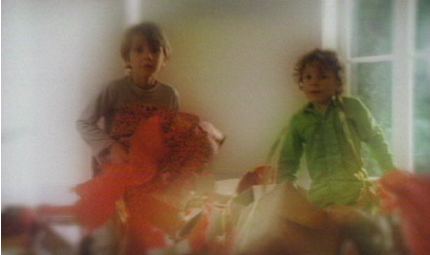 Maria Marshall’s President Bill Clinton, Memphis, Nov. 13, 1993 charts a Sisyphean cycle. Unwrapping nothing reverses into clean-up before rolling on again. Still, the idea that the work parents do (or don’t do) influences their offspring is undeniable.
Maria Marshall’s President Bill Clinton, Memphis, Nov. 13, 1993 charts a Sisyphean cycle. Unwrapping nothing reverses into clean-up before rolling on again. Still, the idea that the work parents do (or don’t do) influences their offspring is undeniable.
Marshall is part of Parenthesis, an exhibit that examines the connective tissue between parents and children. It’s art made from life’s glue.
Because Parenthesis is largely video, its curator (Western Bridge director Eric Fredericksen) worried that sound overlaps would produce a muddle. Instead of retreating to headphones, he hired theater designer Jennifer Zeyl to shape the space to contain individual sounds as well as enlarge the theme.
She created a house with the trappings of home, based on the upper-middle class tract version she grew up inside. (Photo via Best Of)
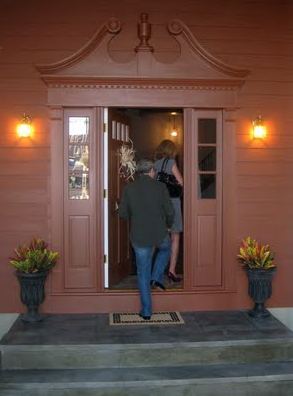 Before you enter, you’re already inside, having passed by Ann Hamilton’s video Still 3 from 2001 inset into a wall by the reception desk. Still 3 is small and easy to ignore, but once you stop, you’re hooked. It features a mother’s voice as she examines an ultrasound video of her baby.
Before you enter, you’re already inside, having passed by Ann Hamilton’s video Still 3 from 2001 inset into a wall by the reception desk. Still 3 is small and easy to ignore, but once you stop, you’re hooked. It features a mother’s voice as she examines an ultrasound video of her baby.
I think a lot of the very abstract quality of my work – and the literal
quality of it – is always dealing with a state or a place or an edge, a
border, a threshold, a place that’s in between. (more)
Behind the Hamilton are a cluster of terrific photographs: Kerry Tribe‘s Dad’s Books, My Film Equipment from 2006; Sally Mann‘s Burgers from 1988, when her children were young; Matthew Cox’s impenetrable Family Portrait, shot in 2008 on a digital camera with the lens removed, and Tina Barney‘s The Son from 1987.
Instead of Barney’s usual Upper East Side Manhattan wealth, she offers Upper West Side intellectuals, and yet the subject is the same: parents and children. (Image via) What could this kid have done to be subject to such heat? Missed an appointment with his S.A.T. coach?
[Read more…] about Western Bridge: “Parenthesis” as entangling alliance
Recycled Visions: The Films of Salise Hughes will be screened at the Northwest Film Forum Oct. 12, 8 p.m., courtesy of Third Eye Cinema, with live music from original scores.
Still from There Were Houses Here, 2007.
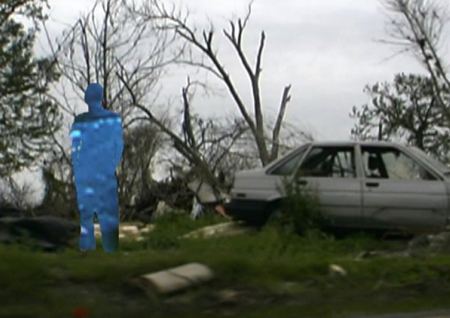 A primitive version of Tidal Wave here, which is stilted compared to the real thing but still good.
A primitive version of Tidal Wave here, which is stilted compared to the real thing but still good.
Info from Web site:
Visual artist Salise Hughes began experimenting with found film footage four years ago, creating her own unique process of digitally erasing and layering areas of the film image. Recycling is a major theme of her work, tearing apart existing 16 mm educational, and Hollywood genre films and rebuilding them, subverting the original material and giving the footage new meaning. Her films have screened in festivals around the globe including International Film Festival Rotterdam, Athens Greece International Film Festival, L’Alternativa-Independent de Barcelona, Seattle International Film Festival and the Ann Arbor Film Festival were she won an award for Technical Innovation in 2006. For this event composer Jason Staczek, and vocalists Alicia Dara and Mia Katerine Boyle will perform their scores live.
KUNSTFEHLER-FEHLERKUNST (Failed Art – The Art of Failure) ran at the ACC Galerie in Weimar till August 9th and is now at Halle 14 in Leipzig through Oct. 25.
Peter Santino’s contribution is a field of sand hemispheres that spell an apology in Braille. If the blind read it, they’ll ruin it.
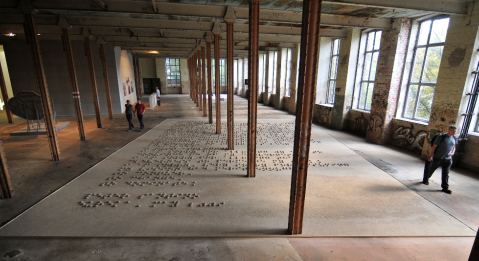 Ambivalent regrets are nothing new for the (former Seattle) Northern California artist. In various forms, his apology text has been in motion since 1995, when, presumably, he first realized the error of his ways.
Ambivalent regrets are nothing new for the (former Seattle) Northern California artist. In various forms, his apology text has been in motion since 1995, when, presumably, he first realized the error of his ways.
Translation:
Whomever,
On January 25th, 1968, when I first began my creative work, I felt certain I
had something to offer, a vision, something to put into the world. Now, some 41
years later, it has become clear that what I must offer is my sincere apology.
Nineteen years ago, I recognized and embraced my failure; my failure to
achieve a measurable level of artistic communication. Despite numerous exhibitions
and more than sufficient opportunities to explain my vision, no thing has been
achieved.
I must apologize:
I am Sorry for allowing my ego to convince me of my cleverness.
I am Sorry for allowing that cleverness to permeate my work.
I am Sorry, Very Sorry for assuming my vision had merit enough
to conquer,
to change,
to dominate.Peter Santino
Eureka, May 2009
Update: Dave Hickey discusses the reasons for art failure in a lecture taped by James Kalm, which the lecture hosts want to take down so watch them soon, part one here. Charlie Finch calls him a bulbous phony here. I don’t agree with a lot Hickey has to say this time out, but whatever he’s saying, he can’t be written off as a phony. Finch and Hickey have more in common than either is likely to own. Both are good writers with a tendency to swing wide at the lip.
First sad sack: We were raised in a corridor. We longed for a room.
Second sad sack: We longed for a corridor. We were raised on
a road.
Not since 17th-century Chinese painters focused on the fluid connectives between forms has empty space been as riveting a subject as it is now.
Rachel Whiteread is crucial in this context, but by the time she began to explore the space between legs of a chair, for instance, Bruce Nauman had already been there and gone. (The peerless Peter Schjeldahl described their relationship as Nauman’s Chuck Berry to Whiteread’s Beatles.)
In Seattle, Leo Saul Berk has his own version of the theme: empty space as landscape narrative. In his exhibit at Lawrimore Project, Deep, Dark, he maps the volumes of famous undergrounds, including the hole in which Saddam Hussein unsuccessfully sought refuge after the U.S. invasion of his country on trumped-up charges.
Spider Hole, 2009 Fiberglass, foam, resin and glass. 6 x 4 x 10 feet.
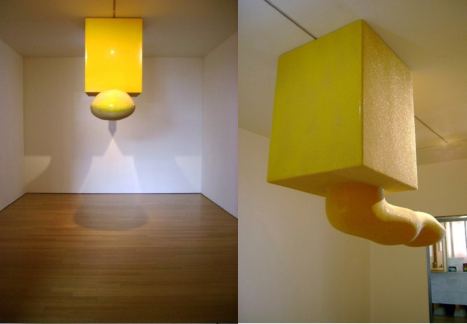 Berk gives volume to the photos, schematics and renderings of the box-cave trailing a partial tunnel that the U.S. military released to the media. Hanging from the ceiling and painted yellow to mirror U.S. ridicule of the sole occupant, Spider Hole is a positive projection asserting itself with a phallus, snake, tongue and weapon.
Berk gives volume to the photos, schematics and renderings of the box-cave trailing a partial tunnel that the U.S. military released to the media. Hanging from the ceiling and painted yellow to mirror U.S. ridicule of the sole occupant, Spider Hole is a positive projection asserting itself with a phallus, snake, tongue and weapon.
Who’s weapon? Not the butcher of Baghdad’s. Glass beads ordinarily used for roadway strips give the piece its disco glitter.
Quecreek Mine, 2009 Acrylic and walnut. 30 x 2.5 x 22 feet. 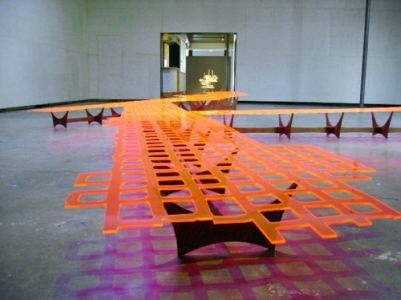
The
Quecreek Mine collapse came after 9/11 and during the build up to the
Iraq War. Nine men trapped 240-feet underground managed to run to the
highest point of their three-to-five feet high coffin and find a bubble
of air as water roofed the structure.
Thanks to the miners
themselves and the rescue crew of engineers who did everything right,
everybody got out alive. There was only one side to be on during the
78-hour ordeal. When that side won, it was a rare piece of good news
for a rattled country. For a moment or two, everybody ignored the
inherently flawed nature of an industry tearing up the earth and using
humans as disposal parts.
Orange acrylic dips and rises as it tracks a layout through an echoing grid of purple shadows. Cracked in spots and porous throughout, the piece is tapped out, with empty squares where earth used to be. As Chinese landscapes move from earth to sky to water, Quecreek Mine also metaphor for the river that ran through it.
After running on a regular basis earlier in the summer, Stokley Towles’ Waterlines surfaces again for two performances at Noodle Works Studios, Oct. 18 and 25. (Info here)
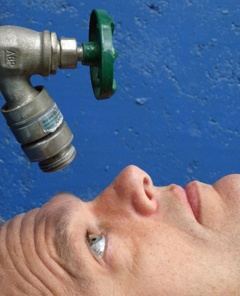
It’s about the rats in your toilets (they’re really
there), about the invention of near beer (as a safe alternative to
drinking water, since the low alcohol content supposedly killed germs),
and about a local man named Mel who has walked 90 percent of Seattle’s
sewer pipes (the things he’s found there: a tricycle; part of a canoe;
a secret reading room with desk, chair, and plywood floorboard that
somebody obviously set up as a private hideaway–Mel, Towles says, let
it be).Other topics discussed: secret tunnels leading to springs, accidentally
demolished in Israel; what parts of Seattle have the most fat- and
oil-clogged sewers; the etymology of “rival” (those who share a river
or a stream); and Seattle’s professional water tasters, whose palates
are more accurate than microscopes in figuring out what kind of algae
are living in the water. (more)
 Dan Webb
Dan Webb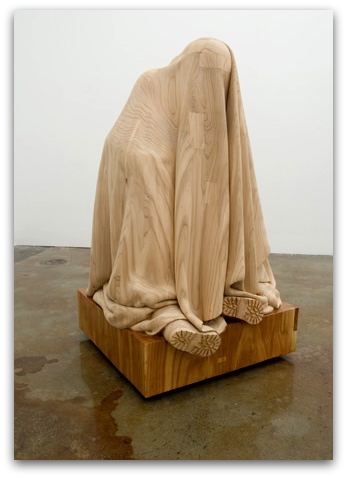 Webb’s Fortress (above) is currently in From Whence that Rainbow Came at Ambach & Rice.
Webb’s Fortress (above) is currently in From Whence that Rainbow Came at Ambach & Rice.
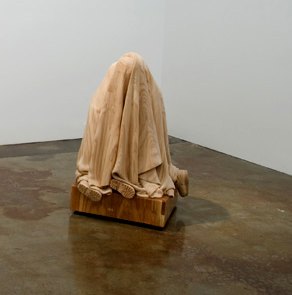
The trees you know are Roxy Paine‘s. They’re all over the place, including at the Seattle Art Museum’s Olympic Sculpture Park. (Image via SAM)
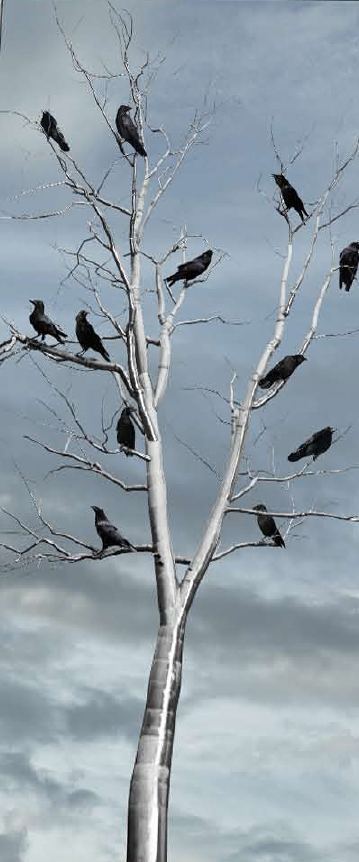 The tree you’re less likely to know:
The tree you’re less likely to know:
Chris Sicat, Redwood Tree Top (Tag a Log) 2009, Graphite on redwood, 14 feet tall (Image via)
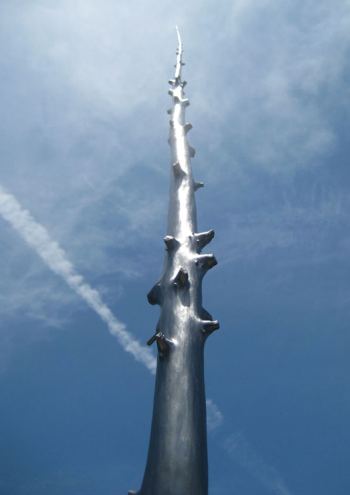 Sicat hand-colored a 14-foot Redwood log with pencil, which he intends as a dialogue between two natural elements: (from Otis)
Sicat hand-colored a 14-foot Redwood log with pencil, which he intends as a dialogue between two natural elements: (from Otis)
I begin with looking at the wood form and the flow of the grain. I smoothen the wood to prep the drawing surface, which is a paradox in that it is a sculpture that is being imagined. At this point, I start to see a non-linear narrative script written out…. and this is where the moments of undefined deuce begins… a buzzing of the electric pencil sharpener… the scratching of the needle point of a soft graphite pencil onto a hard redwood log. The music plays…. miles and miles and miles of Miles Davis, lines after lines after lines til there is an infinite of graphite fibers making a collective mass… the grains finds their moment to rise and descend… the sounds of contemporary chamber music, Erik Satie, Hank Williams, Chemical Brothers, Scott Joplin and Snoop Dog… the crescendo brings the form of the woods and I find quiet moments in the knots and grooves… the hand plots to contemplate… concentrate… and converse back to nature… All this happens in between the engagement of the tag and the log.
an ArtsJournal blog


